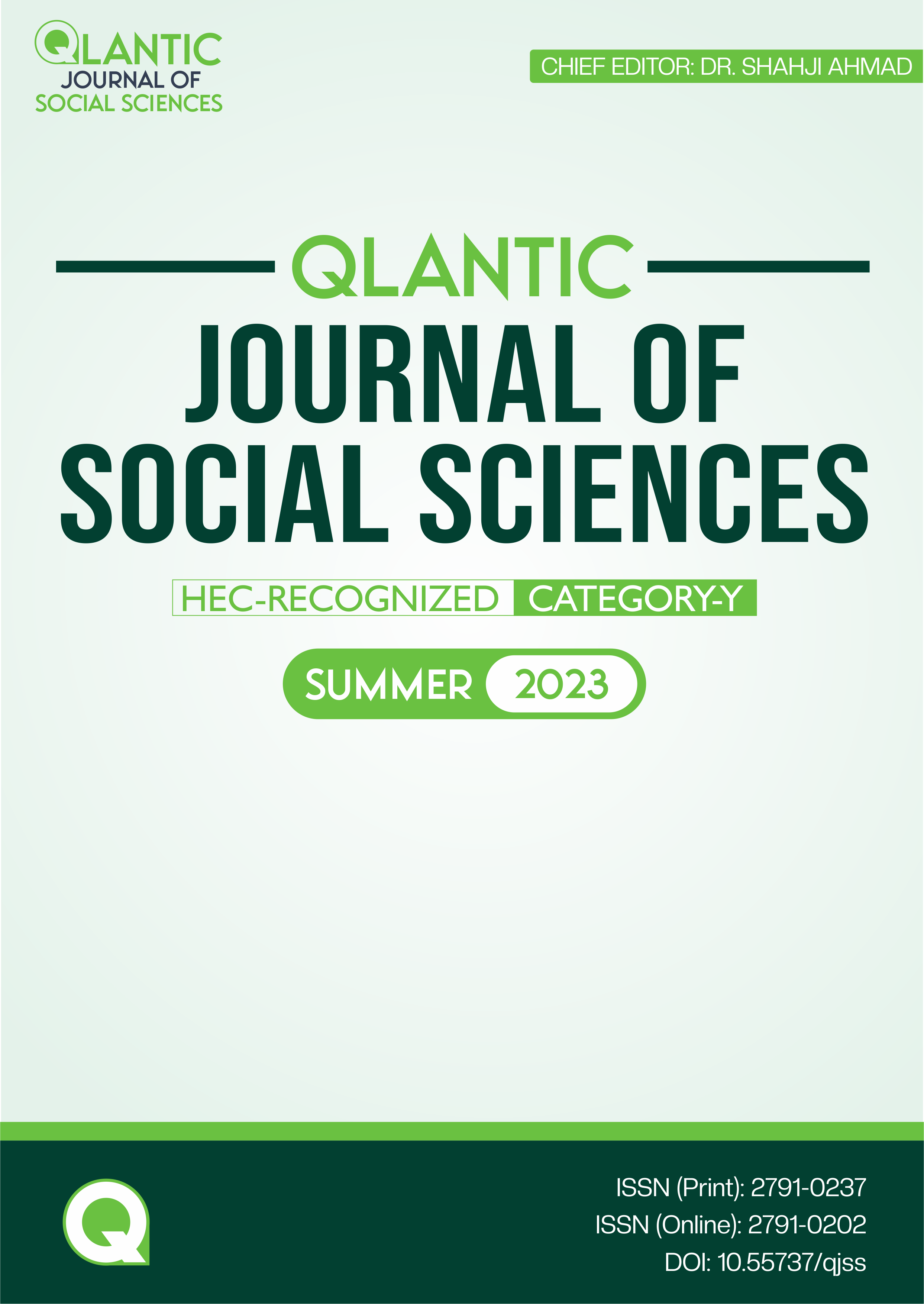The Dance of Debt and Growth in South Asian Economies: Panel ARDL and NARDL Evidence
DOI:
https://doi.org/10.55737/qjss.504418329Keywords:
External Debt, Inflation, PARDL, PNARDLAbstract
This article explores the complicated relationship between external debt and economic growth in South Asian IMF member countries, emphasizing the critical role of external debt in financing development while underscoring the necessity of sensible debt management. Using a diverse regional context, including case studies of India, Bangladesh, Sri Lanka, and Pakistan, it highlights the impact of external debt on economic trajectories within distinct national settings. Employing a comprehensive dataset spanning over three decades and utilizing both Panel Autoregressive Distributed Lag (PARDL) and Panel Nonlinear Autoregressive distributed lag (PNARDL) techniques, the study reveals significant insights into short-term, long-term, and asymmetric dynamics in this relationship. The results underline the importance of sustainable borrowing practices and sensible debt management to sustain long-term economic prosperity. Additionally, the article emphasizes the integral role of government stability, the significance of addressing domestic production limitations, and the critical need for price stability. Policy recommendations are offered to guide South Asian nations in optimizing the positive impact of external debt on economic growth while avoiding potential pitfalls. Overall, this research contributes valuable insights for policymakers and scholars, shedding light on the intricate dynamics of economic growth in this region.
References
Aghion, P., & Bolton, P. (1997). A theory of trickle-down growth and development. The Review of Economic Studies, 64(2), 151. https://doi.org/10.2307/2971707
Agyeman, G., Sakyi, D., & Fosu Oteng-Abayie, E. (2022). External debt and economic growth in selected sub-saharan African countries: The role of capital flight. Research in Globalization, 5, 100091. https://doi.org/10.1016/j.resglo.2022.100091
Chani, M. I., Ahmad, D., Rauf, A., & Afzal, M. (2016). Economic Analysis of cotton Cultivation under Agro-Climatic Conditions of District Muzaffargarh. American-Eurasian Journal of Agricultural and Environmental Science, 16(8), 1498–1503. https://doi.org/10.5829/idosi.aejaes.2016.1498.1503
Ale, S. A., Islam, M. S., & Tun-Nessa, H. (2023). Does external debt affect economic growth: Evidence from South Asian countries. International Journal of Economics and Financial Issues, 13(1), 83-88. https://doi.org/10.32479/ijefi.13527
Al-Fadhat, F., & Raihan Nadhir, M. (2019). Foreign investment and the political economy of Indonesian capital market in 2015-2016. Humanities & Social Sciences Reviews, 7(6), 340-348. https://doi.org/10.18510/hssr.2019.7659
Aloulou, R., Kalai, M., & Helali, K. (2023). The symmetric and asymmetric impacts of external debt on economic growth in Tunisia: Evidence from linear and nonlinear ARDL models. SN Business & Economics, 3(7). https://doi.org/10.1007/s43546-023-00482-9
Khan, A. A., Rauf, A., haq, M., & Anwar, N. (2016). The impact of public debt on economic growth of Pakistan. International Journal of Academic Research in Economics and Management Sciences, 5(2). https://doi.org/10.6007/ijarems/v5-i2/2211
Awan, A. G., & Qasim, H. (2020). The impact of external debt on Economic Growth of Pakistan. Global Journal of Management, Social Scienes and Humanities, 6(1), 30-61.
Azam, M., & Feng, Y. (2015). Does military expenditure increase external debt? Evidence from Asia. Defence and Peace Economics, 28(5), 550-567. https://doi.org/10.1080/10242694.2015.1072371
Barro, R. J. (1990). Government spending in a simple model of Endogeneous growth. Journal of Political Economy, 98(5, Part 2), S103-S125. https://doi.org/10.1086/261726
Chen, Y., Khurshid, A., Rauf, A., Yang, H., & Calin, A. C. (2023). Natural resource endowment and human development: Contemporary role of governance. Resources Policy, 81, 103334. https://doi.org/10.1016/j.resourpol.2023.103334
Chowdhury, A., & Mavrotas, G. (2006). FDI and growth: What causes what? The World Economy, 29(1), 9-19. https://doi.org/10.1111/j.1467-9701.2006.00755.x
Easterly, W. (2001). The Middle Class Consensus and Economic Development. Journal of Economic Growth, 6(4), 317–335. http://www.jstor.org/stable/40216047
Fatima, M., Naz, S., & Khan, S. U. (2023). Energy Consumption, Economic Growth and Environmental Quality in South Asian Developing Countries: A Panel Data Analysis. Research Journal of Social Sciences and Economics Review, 4(2), 244-258. https://doi.org/10.36902/rjsser-vol4-iss2-2023(244-258)
Gul, A., & Khan, A. W. (2021). The Effect of Small-Scale Industries on Employment Level in Pakistan. Journal of Research and Reviews in Social Sciences Pakistan, 4(2), 1393-1404.
Gul, A., Khan, S. U., & Abbasi, R. A. (2023). Vicious Circle of Health Expenditure: Time Series Evidence from Pakistan. Journal of Contemporary Macroeconomic Issues, 4(1), 57–77. https://ojs.scekr.org/index.php/jcmi/article/view/99
Im, K. S., Pesaran, M., & Shin, Y. (2003). Testing for unit roots in heterogeneous panels. Journal of Econometrics, 115(1), 53-74. https://doi.org/10.1016/s0304-4076(03)00092-7
Lau, E., Moll de Alba, J., & Liew, K. (2022). Debt and economic growth in Asian developing countries. Economic Analysis and Policy, 76, 599-612. https://doi.org/10.1016/j.eap.2022.09.011
Levin, A., Lin, C., & James Chu, C. (2002). Unit root tests in panel data: Asymptotic and finite-sample properties. Journal of Econometrics, 108(1), 1-24. https://doi.org/10.1016/s0304-4076(01)00098-7
Mupunga, N., & Roux, P. L. (2015). Estimating the optimal growth-maximising public debt threshold for Zimbabwe. Southern African Business Review, 19(3), 102–128. https://www.unisa.ac.za/contents/faculties/service_dept/docs/Sabview_19_3_chap5.pdf
Pesaran, M. H., & Shin, Y. (1995). An autoregressive distributed lag modelling approach to cointegration analysis (Vol. 9514). Cambridge, UK: Department of Applied Economics, University of Cambridge
Pesaran, M. H., Shin, Y. E., & Smith, R. (1997). Pooled estimation of long-run relationships in dynamic heterogeneous panels. RePEc: Research Papers in Economics. https://EconPapers.repec.org/RePEc:cam:camdae:9721
Rauf, A., & Khan, A. A. (2017). Impact of foreign debt on economic growth: Evidence from Pakistan. Asian Economic and Financial Review, 7(10), 1005-1013. https://doi.org/10.18488/journal.aefr.2017.710.1005.1013
Reinhart, C. M., & Rogoff, K. S. (2010). Growth in a time of debt. American Economic Review, 100(2), 573-578. https://doi.org/10.1257/aer.100.2.573
Šević, Ž. (2007). 1. Managing Public Debt: A Central and/or Local Government Issue. Debt Management in Transition Countries: Experience and Perspectives, 11.
Sharaf, M. F. (2021). The asymmetric and threshold impact of external debt on economic growth: New evidence from Egypt. Journal of Business and Socio-economic Development, 2(1), 1-18. https://doi.org/10.1108/jbsed-06-2021-0084
Wangui, A. M. (2019). External Debt and Economic Growth; Lessons for Africa From South East Asia (Doctoral dissertation, University of Nairobi).




